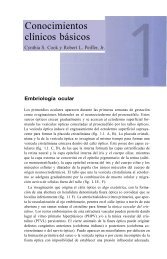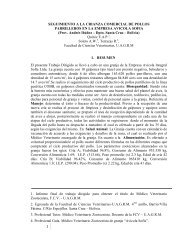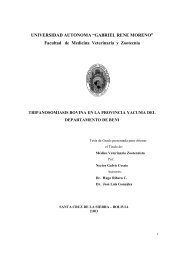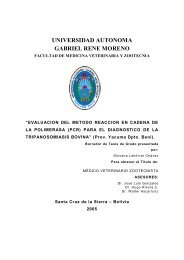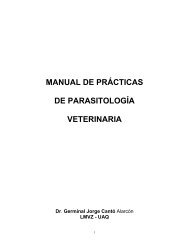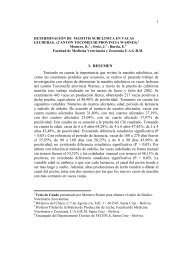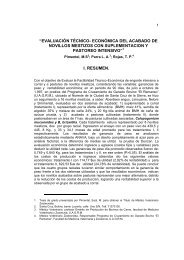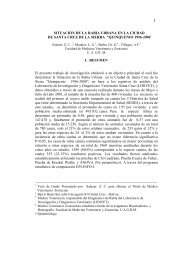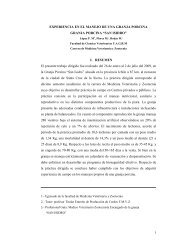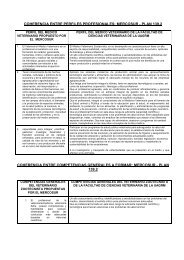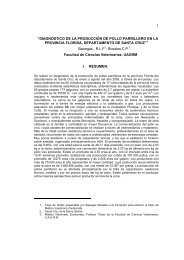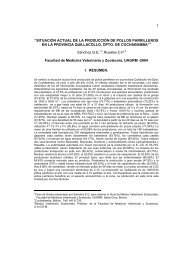591 2697 Medicina In.. - Facultad de Ciencias Veterinarias - UAGRM
591 2697 Medicina In.. - Facultad de Ciencias Veterinarias - UAGRM
591 2697 Medicina In.. - Facultad de Ciencias Veterinarias - UAGRM
Create successful ePaper yourself
Turn your PDF publications into a flip-book with our unique Google optimized e-Paper software.
Figura 61-3 A, Sonograma <strong>de</strong>l testículo <strong>de</strong>recho normal y B, testículo<br />
izquierdo con un seminoma en un Bulldog inglés <strong>de</strong> 9 años ¡nfértil,<br />
Después <strong>de</strong> la hemicastración el animal fue padre <strong>de</strong> una carnada <strong>de</strong><br />
9 cachorros. Las marcas representan 1 cm.<br />
Sin embargo, la calidad <strong>de</strong>l semen pue<strong>de</strong> o no mejorar<br />
<strong>de</strong>spués <strong>de</strong> extraer el testículo neoplásico. Después<br />
<strong>de</strong> la castración, el diagnóstico <strong>de</strong>finitivo se establece<br />
sobre la base <strong>de</strong> los resultados <strong>de</strong> la histopatología <strong>de</strong>l<br />
material extraído. Los perros con supresión <strong>de</strong> la médula<br />
ósea pue<strong>de</strong>n requerir atención <strong>de</strong> sostén, como<br />
transfusión sanguínea para tratar la anemia o trombocitopenia.<br />
Los antibióticos sistémicos pue<strong>de</strong>n ser necesarios<br />
en los animales granulocitopénicos para ayudar<br />
a prevenir la infección. El pronóstico para la recuperación<br />
<strong>de</strong> la médula ósea es reservado a malo. La evolución<br />
favorable a menudo <strong>de</strong>manda meses y luego<br />
apenas el 30% <strong>de</strong> los afectados se recupera. Pue<strong>de</strong><br />
consi<strong>de</strong>rarse el tratamiento <strong>de</strong> las lesiones metastásicas<br />
con cirugía o quimioterapia, o ambas, pero el pronóstico<br />
es grave (véanse caps. 78 y 79).<br />
LECTURAS SUGERIDAS<br />
Concannori PW et al, editors: Fertílity and ínfertility in dogs, cats<br />
and other carnivores, J Kepmd Fértil Suppt47; 1993.<br />
Eleock LH, Schoning P: Age-related changes in the cat testis and<br />
epididymis, Am \ Vet Res 45:2380-2384, 1984.<br />
CAPITULO 61 Enfermeda<strong>de</strong>s <strong>de</strong>l pene, prepucio y testículos<br />
ivith chronic Brucella a ons, AmJ Ve! fies 45:274-281,<br />
1984.<br />
Griffin JE: Androgen resistance—the dínical lolecular spectrum,<br />
N Engtj Mea 326:611 -618, 1992.<br />
lohnston SD: Dísor<strong>de</strong>rs of the external genitalia of the male. <strong>In</strong> Et-<br />
Phila<strong>de</strong>lphia, 1989, WB Saun<strong>de</strong>rs.<br />
lohnston SD, Rornagnoli SE, editors: Canine reproduction, Vet Clin<br />
NorthAm21-3, 1991.<br />
lohnston SD, Root MV, Olson PNS: Ovarían and testicular function<br />
productive disease, Anim Reprod Sci42:261 -274, 1996.<br />
Milus DL et al: Cryptorehidism and monorchidism ¡n cats, ¡ Am Vet<br />
Meó Assoc 200:1128-1130, 1992.<br />
Rollan FL et al: Postoperative complications of elective surgeries ín<br />
medical records, ¡ Am VelMed Assoc 11:1882-1886, 1996.<br />
Purswell B), Freeman LE: Reproduction ¡n the canine male, Canine<br />
Pract 18:8-14, 1993.<br />
Ruble RP, Hird DW: Congenital abnormalities in immature dogs<br />
from a pet store: 253 cases (1987-1988), } Am Vet Mea Assoc<br />
202:633-636, 1993.<br />
Wilson DV et al: Pharmacologic treatrnent of príapism ¡n two horses,<br />
¡Am Vel Med Assoc ~\ 99:11 83-1184, 1991.




